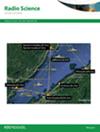The ionospheric exploration based on TJU#01 meteorological microsatellite mission: Initial results
IF 1.6
4区 地球科学
Q3 ASTRONOMY & ASTROPHYSICS
引用次数: 0
Abstract
The global navigation satellite system radio occultation technique is achieving increasing significance and extensive promotion in the remote sensing of near-earth atmosphere, climate, and ionosphere in recent three decades. Nowadays, many communities become interested in developing commercial mode in occultation measurement by launching massive nano- or cube satellite constellations at low costs. The TJU#01 is the first meteorological satellite of Tianjin Yunyao Aerospace Technology Co., Ltd. which was successfully launched into space on 7 December 2021. The occultation antenna onboard the satellite is able to probe both the ionosphere and atmosphere at multi-frequencies including GPS, GLONASS, and BEIDOU systems. The microsatellite applies the same occultation antenna to receive both the atmospheric and ionospheric occultations at 100 and 1 Hz respectively. 100 Hz narrow band power and wide band power data are downloaded to the ground to generate high-rate signal-to-noise ratio (SNR) series and applied to ionospheric scintillation exploration. In this paper, the primary parameters of the satellite and occultation antenna are introduced, as well as the ionospheric data processing methodologies. The initial ionospheric products of TJU#01 are evaluated after one-month in orbit. The TJU#01 results have a good agreement with the co-located ground ionosonde data and COSMIC-2 observations. The new satellite and its follow-on missions have great capabilities and potentials in the ionospheric and space weather researches.基于 TJU#01 气象微卫星任务的电离层探测:初步结果
近三十年来,全球导航卫星系统无线电掩星技术在近地大气、气候和电离层遥感方面的意义日益重要并得到广泛推广。如今,许多团体开始关注通过发射大规模、低成本的超小型或立方体卫星星座来发展掩星测量的商业模式。天津云遥 01 号是天津云遥航天技术有限公司的首颗气象卫星,于 2021 年 12 月 7 日成功发射升空。卫星上搭载的掩星天线可同时探测电离层和大气层,探测频段包括GPS、GLONASS和北斗系统。微型卫星使用同一掩星天线,分别以 100 赫兹和 1 赫兹的频率接收大气层和电离层的掩星。100 赫兹窄带功率和宽带功率数据下载到地面,生成高速率信噪比(SNR)序列,并应用于电离层闪烁探测。本文介绍了卫星和掩星天线的主要参数以及电离层数据处理方法。在轨道上运行一个月后,对 TJU#01 的初始电离层产品进行了评估。TJU#01 的结果与共址地面电离层数据和 COSMIC-2 的观测结果吻合良好。新卫星及其后续任务在电离层和空间气象研究方面具有巨大的能力和潜力。
本文章由计算机程序翻译,如有差异,请以英文原文为准。
求助全文
约1分钟内获得全文
求助全文
来源期刊

Radio Science
工程技术-地球化学与地球物理
CiteScore
3.30
自引率
12.50%
发文量
112
审稿时长
1 months
期刊介绍:
Radio Science (RDS) publishes original scientific contributions on radio-frequency electromagnetic-propagation and its applications. Contributions covering measurement, modelling, prediction and forecasting techniques pertinent to fields and waves - including antennas, signals and systems, the terrestrial and space environment and radio propagation problems in radio astronomy - are welcome. Contributions may address propagation through, interaction with, and remote sensing of structures, geophysical media, plasmas, and materials, as well as the application of radio frequency electromagnetic techniques to remote sensing of the Earth and other bodies in the solar system.
 求助内容:
求助内容: 应助结果提醒方式:
应助结果提醒方式:


